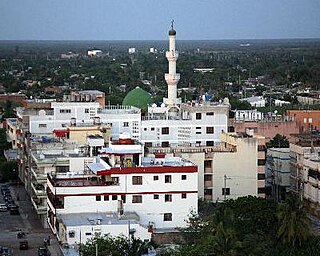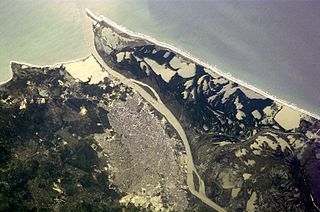
Barranquilla is the capital district of the Atlántico department in Colombia. It is located near the Caribbean Sea and is the largest city and third port in the Caribbean coast region; as of 2018, it had a population of 1,206,319 making it Colombia's fourth-most populous city after Bogotá, Medellín, and Cali.

Asian Argentines, are Argentine citizens or residents of Asian ancestry. The vast majority trace their ancestry to West Asia, primarily Lebanon and Syria, and East Asia, namely China and Japan. Though there are other communities of South Asian or Southeast Asian origin as well. Asian-Argentines settled in Argentina in large numbers during several waves of immigration in the twentieth century.

Maicao is a city and municipality in the Department of La Guajira, northern Republic of Colombia. It is located 76 km from Riohacha, the capital of the department and is the second largest urban center near the border with Venezuela, after the city of Cúcuta.

Islam in Colombia is a minority religion, with most Colombians adhering to Christianity (Catholicism). According to a 2018 study conducted by Pew Research Center, the size of the Colombian Muslim population ranges from about 85,000–100,000 people out of a total population of 50.4 million. However, according to official estimates the Colombian Muslim community numbered just 10,000 people or 0.02% of the total Colombian population. Most Colombian Muslims are immigrants from the Arab World along with a small number of local converts.

The Caribbean region of Colombia or Caribbean coast region is in the north of Colombia and is mainly composed of 8 departments located contiguous to the Caribbean. It's the second most populated region in the country after Andean Region with approximately 11 million residents according to the Colombian Census 2018. The area covers a total land area of 110,000 km2 (42,000 sq mi), including the Archipelago of San Andrés, Providencia and Santa Catalina in the Caribbean Sea.

Colombians are people identified with the country of Colombia. This connection may be residential, legal, historical or cultural. For most Colombians, several of these connections exist and are collectively the source of their being Colombian.
Arab Colombians refers to Arab immigrants and their descendants in the Republic of Colombia. Most of the migrants came from Lebanon, Jordan, Syria and Palestine. When they were first processed in the ports of Colombia, they were classified as Turks because what is now Lebanon, Syria, Jordan and Palestine were then territories of the Ottoman Empire. It is estimated that Colombia has a Lebanese population of 3.2 million. Meanwhile the Palestine population is estimated between 100,000-120,000.

Immigration to Colombia during the early 19th and late 20th Century, is what makes it one of the most diverse countries in the world, above other countries in the Latin region. Colombia inherited from the Spanish Empire harsh rules against immigration, first in the Viceroyalty of New Granada and later in the Colombian Republic. The Constituent Assembly of Colombia and the subsequent reforms to the national constitution were much more open to the immigrants and the economic aperture. However naturalization of foreigners, with the exception of those children of Colombians born abroad, it is still difficult to acquire due 'Jus soli' law is not allowed by the government, and only 'Jus sanguinis' law is accepted. Immigration in Colombia is managed by the "Migración Colombia" agency.
Arab Argentine refers to Argentine citizens or residents whose ancestry traces back to various waves of immigrants, largely of Arab ethnic, cultural and linguistic heritage and/or identity originating mainly from what is now Lebanon and Syria, but also some individuals from the twenty-two countries which comprise the Arab world such as Palestine, Egypt and Morocco. Arab Argentines are one of the largest Arab diaspora groups in the world.
Arab Venezuelans refers to Venezuelan citizens of Arab origin or descent. There are around 1,600,000 Venezuelans of Arab origin, mainly from Lebanon, Syria and Palestine. Most Arab Venezuelans are of Syrian descent with their number between 400,000 and 1 million inhabitants, and Lebanese descent with their number between 341,000 and 500,000.
White Colombians are the Colombian descendants of European and Middle Eastern people living in Colombia. According to the 2018 census, 87.58% of Colombians do not identify with any ethnic group, thus being either white or mestizo, which are not categorized separately.
Race and ethnicity in Colombia descend mainly from three racial groups—Europeans, Amerindians, and Africans—that have mixed throughout the last 500 years of the country's history. Some demographers describe Colombia as one of the most ethnically diverse countries in the Western Hemisphere and in the World, with 900 different ethnic groups. Most Colombians identify themselves and others according to ancestry, physical appearance, and sociocultural status. Social relations reflect the importance attached to certain characteristics associated with a given racial group. Although these characteristics no longer accurately differentiate social categories, they still contribute to one's rank in the social hierarchy. A study from Rojas et al involving 15 departments determined that the average Colombian has a mixture of 47% Amerindian 42% European, and 11% African. These proportions also vary widely among ethnicities.
The History of the Jews in Colombia begins in the Spanish colonial period with the arrival of the first Jews during the Spanish colonization of the Americas.
German Colombians are Colombian citizens of German ancestry. They may be descendants of Germans who immigrated to Colombia from Germany or elsewhere in Europe. Most German Colombians live in the departments of Andean Region and Caribbean Region. Germans have been immigrating to Colombia since at least 16th century. During World War II, thousands of Germans fled to Colombia.

Polish Colombians are Colombian citizens of full or partial Polish ancestry, or Polish-born person residing in Colombia. Most of the Polish immigrants that fled from the Holocaust to Colombia were Polish Jews.

Gabriela Tafur Náder is a Colombian lawyer, model and beauty pageant titleholder who was crowned Miss Colombia 2018. She represented Colombia at Miss Universe 2019 and reached the Top 5.

Arab Cubans refers to Arab immigrants and their descendants in Cuba and the Cuban diaspora. Most of Cuba's Arab community come from Syrian, Lebanese or Palestinian backgrounds.
Syrian Colombians are Colombians of Syrian descent. Most of the ancestors of the Syrian community emigrated to Colombia from the Ottoman Empire in the late 19th and early 20th centuries for economic, political and religious reasons. The first Syrian moved to Colombia in the late nineteenth century. The great wave of Syrian migration began around 1880. This was perhaps the highest peak during the first three decades from 1880 and counting with a great decrease in the migratory flow after 1930. The Syrians as well as the Lebanese and the Palestinians Since then they continued with their establishment in the north of Colombia, mainly the Bolivar savannah, corresponding today to the departments of Córdoba and Sucre. Córdoba being the largest recipient of Syrian, Lebanese and Palestinian migration in the entire region, it is estimated that between 50,000 and 100,000, which makes the Syrians, only behind the Lebanese, as the second largest group of immigrants in Colombia since independence.









